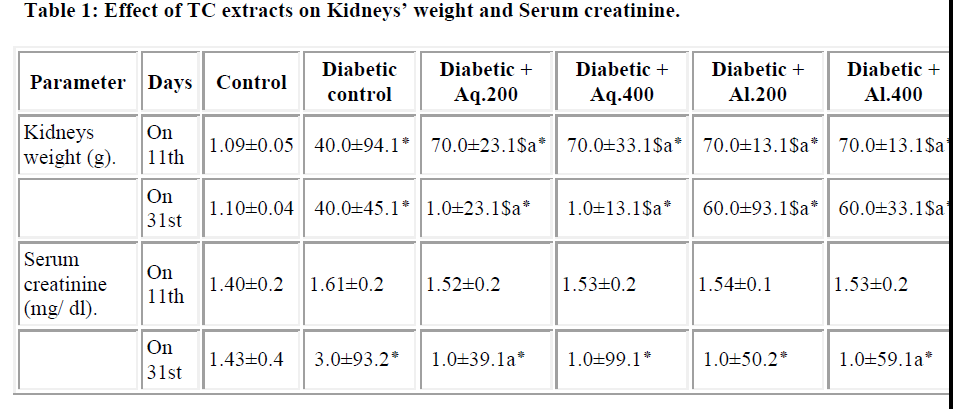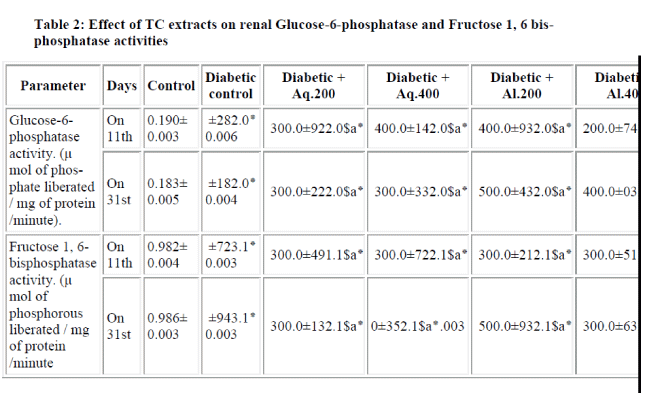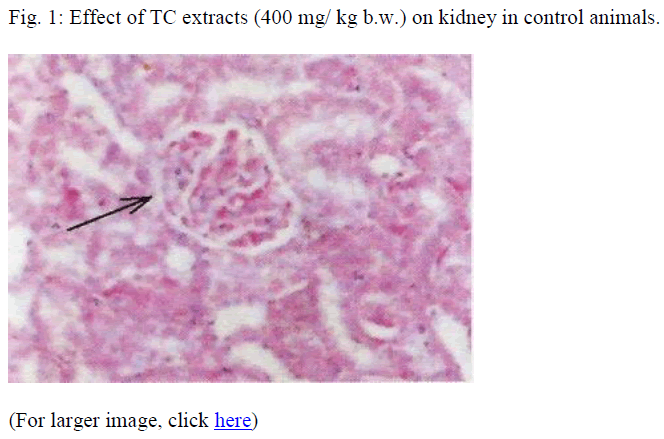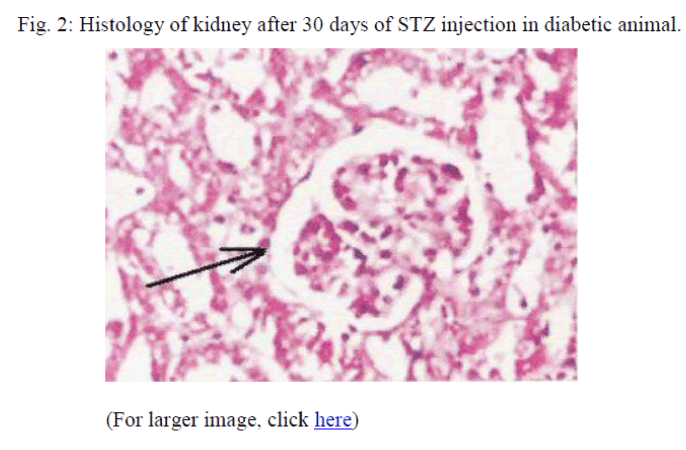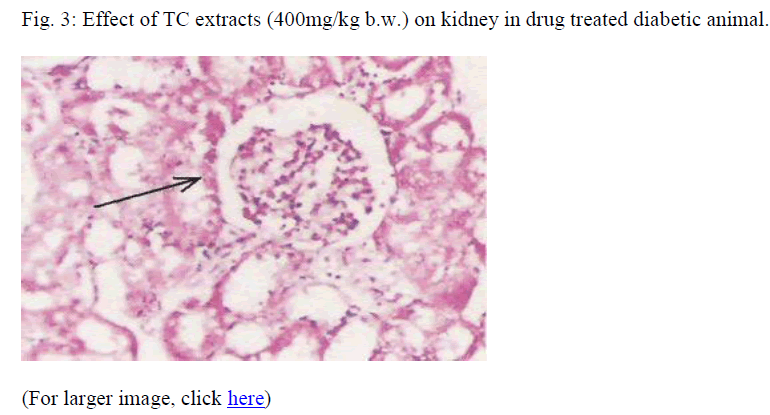ISSN: 0970-938X (Print) | 0976-1683 (Electronic)
Biomedical Research
An International Journal of Medical Sciences
- Biomedical Research (2007) Volume 18, Issue 3
Modulation of morphology and some gluconeogenic enzymes ac-tivity by Tinospora cordifolia (Willd.) in diabetic rat kidney
1Nagaraja Puranik. K, 3K.F. Kammar, 2Sheela Devi
1Department of Physiology, Karnataka Institute of Medical Sciences, Hubli, Karnataka, India
2Department of Physiology, Dr. ALM. PG. Institute of Basic Medical Sciences, University of Madras, Taramani Campus, Chennai, Tamilnadu, India
3Department of Physiology, Karnataka Institute of Medical Sciences, Hubli, Karnataka, India
- Corresponding Author:
- Nagaraja Puranik. K
Department of Physiology Karnataka
Institute of Medical Sciences Hubli 580 022
Karnataka, India
Phone: 0091-836- 2370057 Extn. 281
Fax: 0091-836- 2278097
Mobile : 0091-9448870096
e-mail: puranik_nk ( at ) yahoo.com
Accepted date: May 07 2007
Effect of Tinospora cordifolia (Willd.) (TC) stem extracts (both aqueous and alcoholic) in different dosages (200 and 400 mg/ kg b.w) on kidney weight, morphology, serum creatinine, renal gluconeogenic enzymes Glucose-6-phosphatase and Fructose 1, 6-bisphosphatase activity in streptozotocin induced diabetic albino rats was investigated in this study. The drug was administered orally for 10 and 30 days in different groups. Efficacy of TC in modulating all these altered parameters caused by diabetes was compared with the Lante Zinc Insulin (6 Units / kg b.w. daily. i.p.) treated diabetic rats. Drug treated diabetic animals showed a significant effect (p< 0.05) of TC on all these parameters except renal morphology, compared to untreated animals. Moreover, the drug administration in control animals did not induce significant change in any one of these parameters, showing that TC administration is safe in normal animals.
Keywords
Tinospora cordifolia, Diabetes mellitus, Streptozotocin, Gluconeogenic, Nephropathy
Abstract
Effect of Tinospora cordifolia (Willd.) (TC) stem extracts (both aqueous and alcoholic) in different dosages (200 and 400 mg/ kg b.w) on kidney weight, morphology, serum creatinine, renal gluconeogenic enzymes Glucose-6-phosphatase and Fructose 1, 6-bisphosphatase activity in streptozotocin induced diabetic albino rats was investigated in this study. The drug was administered orally for 10 and 30 days in different groups. Efficacy of TC in modulating all these altered parameters caused by diabetes was compared with the Lante Zinc Insulin (6 Units / kg b.w. daily. i.p.) treated diabetic rats. Drug treated diabetic animals showed a significant effect (p< 0.05) of TC on all these parameters except renal morphology, compared to untreated animals. Moreover, the drug administration in control animals did not induce significant change in any one of these parameters, showing that TC administration is safe in normal animals.
Introduction
Diabetes mellitus (DM) is a metabolic disorder, which affects the people of all age groups and from all walks of life. There are estimated 150 million people world wide sufferings from diabetes [1], which is almost five times more than the estimated number ten years ago.
Management of diabetes without any side effect is still a challenge to the medical field, as presently available drugs for diabetes have one or other adverse effects. Since the existing drugs for treatment of DM do not satisfy our need completely, search for the new drugs continues. In recent years, the herbal remedy for the unsolved medical problems is gaining importance in research field. In present study, the attempt was made to test the anti-diabetic activity of Tinospora cordifolia (TC) and to study its effect in modulating the kidney morphology and some gluconeogenic enzymes in STZ diabetic rats’ kidneys since diabetic nephropathy is one of the major complications in long term diabetes mellitus. Efficacy of these effects was compared with standard drug insulin.
Tinospora cordifolia (Willd.) Miers ex Hook. F. and Thoms. (TC) belongs to the Menispermaceae family and known as Gulancha in English, Guduchi in Sanskrit, and Giloya in Hindi. It is a large, glabrous, deciduous climbing succulent shrub, commonly found in hedges. It has been known for long in Ayurvedic literature as a tonic, vitalizer and as a remedy for diabetes and other metabolic disorders [2, 3].
Material and Methods
Plant material
Tinospora cordifolia stem was collected fresh from forest areas in Udupi- district, Karnataka state, India and dried in shade and then powdered. The plant was identified by Professor and Head, Department of Botany, Mangala Gangothri, Mangalore University. A specimen (Voucher No. 31) was deposited in the botany department museum. The powdered materials were kept in an air tight container in a refrigerator until the time of use.
Extraction
Aqueous and alcoholic extracts of TC were prepared according to the standard extract procedure [4]. The yield of extracts was approximately 8.5 % and 7% respectively.
Animals and time of experiment
Female albino rats of inbred Wistar strain (body wt. 180-210 g) were used in this study. Animal ethical committee clearance was obtained from Institutional Animal Ethics Committee (IACE No. 08/004/02). The animals were fed on pellet diet (Hindustan Lever Ltd. Bangalore) and water ad libitum through out the study period. All the experiments were carried out in between 8-10 A.M in order to avoid circadian rhythm induced changes.
Experimental Induction of diabetes
To induce diabetes, the rats were fasted for 16 hours and injected with freshly prepared streptozotocin (STZ) (Sigma chemicals, USA) at the dose of 55 mg / kg b.w.
intravenously [5] in 0.1 M Citrate buffer of pH 4.5 [6]. Control animals were received citrate buffer alone.
Diabetes status was confirmed by estimating the fasting blood glucose levels and urine glucose (Benedict’s test) after 72 hours of STZ injection. Animals showing fasting blood glucose levels above 250 mg/dl were selected for this study.
Experimental protocol
All the experimental animals were divided into 7 groups with each group consists of 6 animals as follows
Group 1: Control: This group was used for studying the base line values of the parameters studied. Group 2 Diabetic control: This group consists of streptozotocin induced diabetic rats. Group 3- Diabetic rats treated with (200 mg/kg b.w.) aqueous extract of TC. Group 4- Diabetic rats treated with (400 mg/kg b.w.) aqueous extract of TC. Group 5- Diabetic rats treated with (200 mg/kg. b.w) alcoholic extract of TC. Group 6- Diabetic rats treated with (400 mg/kg. b.w.) alcoholic extract of TC. Group 7- Diabetic rats treated with insulin.
Drug treatment
Single dosage of either aqueous extract (dissolved in normal saline) or alcoholic extract (dissolved in gum acacia) [4] was given orally for 10 days and 30 days to specific groups through oral intubations and the control ani-mals received the vehicle alone. Lante zinc insulin (6 units /kg. b.w. i.p) was given to specific group daily [7].
At the end of the experimental period, animals were killed by cervical decapitation. Serum was collected. Kidneys were removed and washed in ice cold saline, blotted with filter paper and were weighed. One portion of kidney was fixed in 10% buffered formalin for the histological studies. The remaining tissue was kept in a deep freezer (- 200 C) and used for the estimation of enzymes.
Serum creatinine was estimated according to the method of Slot [8].Histology studies of kidneys were carried out according to the procedure of Culling [9]. Glucose-6-Phosphatase (EC 3.1.3.9) and Fructose 1, 6-bis phosphatase (EC 3.1.3.11) activities in kidneys were assayed according to the method of King [10] and Gancedo and Gancedo [11] respectively.
Statistical analysis
Statistical significance between the different groups was determined by One way Analysis of Variance (ANOVA) followed by Tukey’s multiple comparisons by fixing the P value as p< 0.05.
Results
Kidney weight was increased significantly in untreated diabetic rats compared to control during the study period. Treatment with TC and insulin (Table. 1) could protect this increase in kidney weight after 10 days and 30 days of treatment. However, in these rats the kidney weight was still markedly increased compared to control. Serum creatinine levels (Table.1) were not affected significantly for 10 days after inducing diabetes in TC treated as well as in untreated diabetic rats. After 30 days, the TC treated with 200 mg of aqueous and 400 mg of alcoholic extracts could protect effectively the increase in serum creatinine levels unlike untreated diabetic rats, where it was increased to high levels. However, it was not normalized by TC treatment.
Activities of glucose-6- phosphatase and fructose 1, 6 bis phosphatase in kidneys (Table.2) were increased significantly in untreated diabetic rats during the study period.
Gluconeogenic enzymes activity by Tinospora cordifolia (Willd.) in diabetic rat kidney 183
Treatment with TC and insulin could significantly decrease the activity of these two enzymes. Efficacy of TC in amelirating all these parameters was equally good, compared to that of insulin (Table.3) showing the high effectiveness of TC in treating diabetes mellitus.
Discussion
Diabetes mellitus is the one of the major disorders which affects the kidneys. Renal hypertrophy is common in experimental DM. In addition to abnormal renal functions, the morphological alterations in kidneys which are seen during the early stages of the disease include a substantial increase in kidney volume [12]. Reports from Sochor et al [13] indicate that the diabetes resulted in 27% increase in kidney weight of adult male rat in 5 days, whereas kidneys of fully grown adult female rats grew by 19% in 3 days and by 39% in 8 days after the induction of diabetes. In present study, kidneys weight was increased significantly in diabetic rats and treatment with TC for 10days and 30 days reduced this increase. This observation may suggest that TC can modify the renal tissues architecture thereby kidneys weight though it was not able to change the altered histology of renal vasculature and glomeruli much.
Profound changes in protein metabolism occur in DM. Enhanced catabolism of muscle proteins in diabetes elevates the serum creatinine levels [14]. Creatinine is a marker of renal functions. In the early phase of diabetic nephropathy, there is a hyper filtration and increase in creatinine clearance resulting in no change in serum creatinine levels but in the later stages the creatinine levels start increasing. Both an increase [15] and no change [16] in serum creatinine levels have been reported in diabetic rodents. In present study, an increase in serum creatinine levels was observed only after 30 days in diabetic rats and these levels were decreased with TC and insulin treatment. From these results, it can be concluded that TC may protect the protein catabolism in muscle or it ameliorates the renal functions in diabetic rats.
Glucose-6-phosphatase and Fructose 1, 6-bisphosphatase are the important regulatory enzymes in gluconeogenic pathway. Glucose-6-phosphatase is one of the key enzymes in the homeostatic regulation of blood glucose levels. It catalyzes the terminal step in both gluconeogenesis and glycogenolysis, converting glucose-6-phosphate to glucose. This enzyme is mainly found in the gluconeogenic tissues liver and kidneys, where it plays a major role in the glucose production [17]. Fructose 1,6-bis phosphatase catalyzes one of the irreversible steps in gluconeogenesis and serves as a site for the regulation of this process [18], catalyzing the conversion of fructose 1,6-bisphosphate to fructose 6-phosphate. Activities of these two enzymes are found to be increased in DM. It was reported that the activity of glucose-6-phosphatase was increased 2-3 fold and the activity of fructose1, 6-bisphosphatase in diabetes was increased 2-5 fold [19]. In the present study, activities of these two enzymes in kidneys were increased in diabetic rats during the study period. Treatment with TC and insulin could significantly decrease their levels in kidneys. This may be one of the means by which TC could decrease the blood glucose levels in treated animals (data not shown). However, treatment with insulin and TC did not bring these enzymes’ level to the normal. That is why blood glucose was not normalized in TC and insulin treated diabetic rats even after the treatment.
This study concludes that the treatment with TC in diabetic rats modulates the renal tissue morphology and ameliorates the activity of key enzymes in gluconeogenic pathways thereby act as an anti- diabetic herbal preparation in diabetic animals.
References
- Marx J. Unraveling the causes of Diabetes. Science 2002; 296: 686-689
- Chopra RN, Chopra IC, Handa KL, Kapur L. Indigenous Drugs of India. 2nd edition. Dhar and sons, Calcutta 1958.
- Nadkarni AK. Indian Materia Medica, vol. 1, 3rd edition. Popular Prakashan, Bombay 1954.
- Gupta SS, Verma SCL, Garg VP, Mahesh Rai. Anti-diabetic effects of Tinospora cordifolia. Effect on fasting blood sugar level, Glucose tolerance and adrenaline induced hyperglycemia. Ind Jour Med Res 1967; 55: 733- 745.
- Chattopadhyay S, Ramanathan M, Das J, Bhattacharya SK. Animal models in experimental diabetes mellitus. Indian J of Experimental Biol 1997; 35: 1141-1145.
- Mitra SK, Gopumadhavan S, Muralidhar TS, Anturlikar SD, Sujatha MB. Effect of a herbomineral preparation D-400 in Streptozotocin induced diabetic rats. Journal of Ethnopharmacol 1996; 54: 41-46.
- Stanely P, Prince M, Venugopal PM, Gunasekaran G. Hypolipidaemic action of Tinospora cordifolia roots in alloxan diabetic rats. J Ethnopharmacol 1999; 64: 53-57.
- Slot C. Plasma Creatinine determination; a new and specific Jaffe reaction method. Scan J clin Lab investigation 1965; 17: 381-387.
- Culling CFA. Hand book of histopathological and histichemical techniques. 3rd edition, Butterworths publication, London 1974.
- King J. Practical Clinical Enzymology. D van Nostrand Co, Philadelphia, London 1965.
- Gancedo JM, Gancedo C. Fructose 1-6- bisphosphatase, phosphofructokinase and glucose-6-phosphate dehydrogenase from fermenting and non-fermenting yeasts. Arch. Microbiol 1971; 76: 132-138.
- Christiansen JS, Gammelgaard J, Frandsen M, Parving H-H. Increased kidney size, glomerular filtration rate and renal plasma flow in short term insulin dependent diabetics. Diabetologia 1981; 20: 451-456.
- Sochor Milena, Sirilaksana Kunjara, Greenbaum AL, Patricia Mc Lean. Renal hypertrophy in experimental diabetes. Biochem J 1986; 234: 573-577.
- Jefferson LS, Warren SL, Lia O, Daniel E. Peavy, Thomas B. Miller, Micheal Cappel, John M. Taylor. Diabetes induced alterations in liver protein synthesis. The J Biological chemistry 1983; 258: 1369-1375.
- Shinde Urmila A, Goyal RV. Effect of chromium picolinate on histopathological alterations in STZ and neonatal STZ diabetic rats. J Cellular and Molecular Medicine 2003: 27-32.
- Murali B, Goyal RK. Effect of chronic treatment with losarton on streptozotocin induced diabetic nephropathy. Clinical and Experimental Hypertension 2001; 23: 513-520.
- Beaudet AL. In: Harrison’s principle of internal medicine, edited by JD Wilson, E Braunwald, KJ Isselbacher et al, 12th edition (Mc Graw Hill, New York) 1991.
- Tejwani GA, Pedrosa FO, Pontremoli S, Horecker BL .Arch Biochem Biophys 1976; 177.
- Gupta Dhananjay, Jayadev Raju, Najma Zaheer Baquer. Modulation of some gluconeogenic enzyme activities in diabetic rat liver and kidney: Effect of antidiabetic compounds. Indian Journal of Experimental Biology 1999; 37: 196-199.
